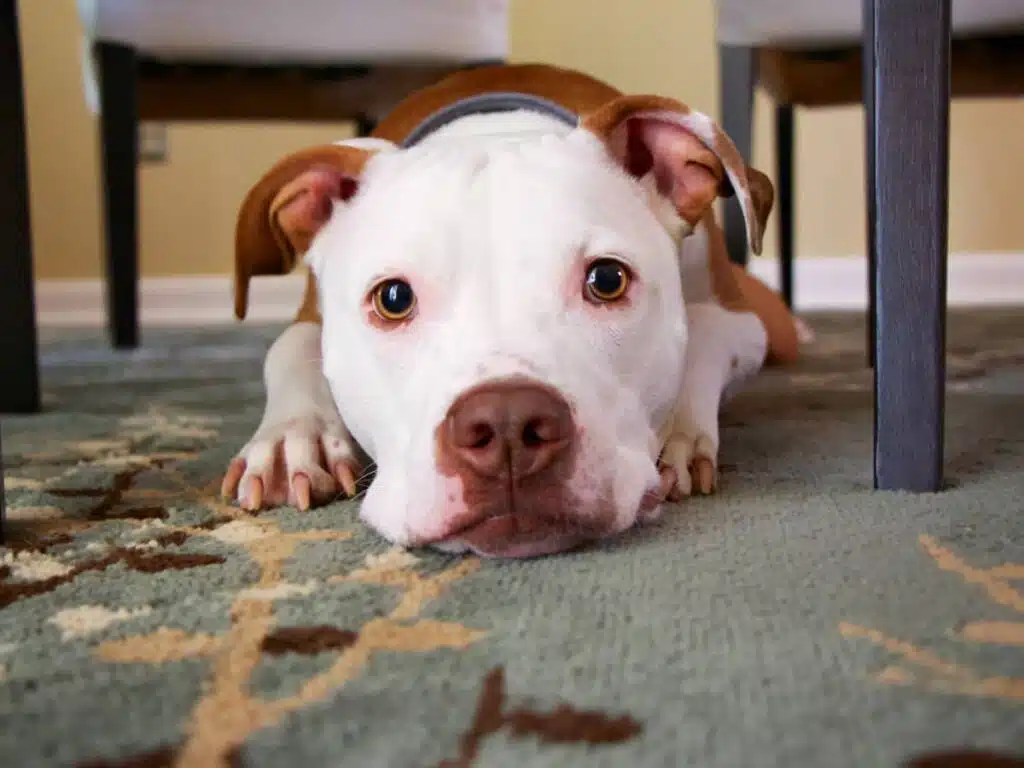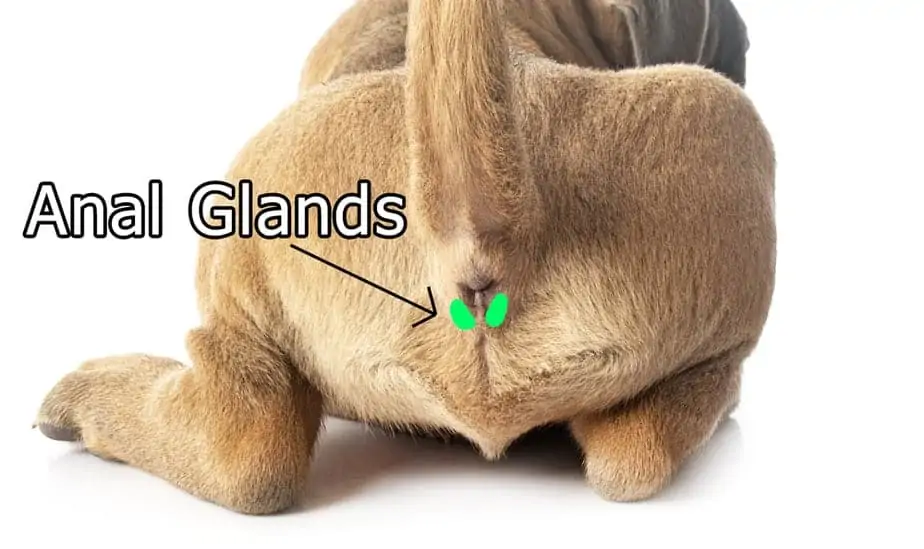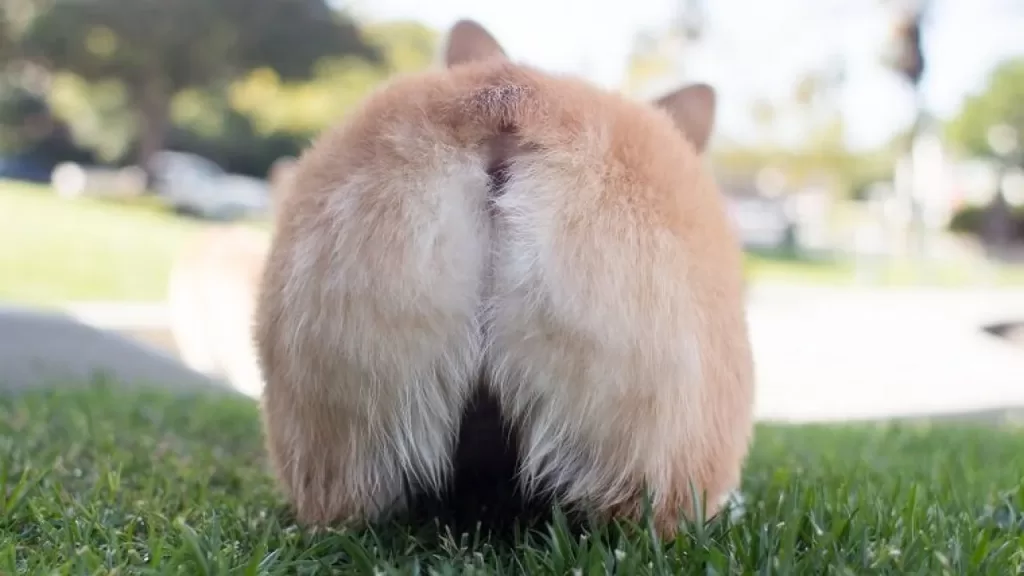Dog hemorrhoids or Hemorrhoids in dogs, much like in humans, are swollen blood vessels located around the rectum and anus. These swollen tissues can lead to discomfort and health issues for our canine friends.
Table of Contents
In dogs, necessity to defecate with more effort becomes a reason of prolapsed rectum. As a result of excessive straining it may also turn out to be the cause of hemorrhoids where the blood vessels in the rectal area swell. Ether way, the conditions are related through the same cause of an elevated pressure on the genital area during defecation.
It’s crucial for pet owners to be aware of dog hemorrhoids – symptoms, causes, and treatment options – to ensure their pets receive timely and effective care. Spotting the signs early can make a significant difference in managing your dog’s comfort and well-being.
Internal vs External Hemorrhoids in Dogs

Hemorrhoids in dogs come in two main types: internal and external. Internal hemorrhoids are found inside the rectum. They are harder to spot since they are not visible from the outside. Your dog might show signs of discomfort, like difficulty sitting or whining when pooping.
On the other hand, external hemorrhoids appear under the skin around the anus. These can sometimes be seen as lumps or swelling, and you might notice your dog licking the area more often.
| Feature | Internal Hemorrhoids | External Hemorrhoids |
|---|---|---|
| Location | Inside the rectum, not visible externally | Located around the anal opening, visible externally |
| Appearance | Typically not visible or palpable | Visible as swollen, tender tissue around the anus |
| Symptoms | Often asymptomatic | May cause discomfort, pain, itching, or bleeding |
| Diagnosis | May require rectal examination or diagnostic imaging | Visible upon visual inspection and palpation |
| Treatment Options | Conservative management, dietary changes, | Conservative management, dietary changes, |
| stool softeners | topical creams or ointments, warm compresses | |
| Severity | Can be harder to detect and diagnose | Easier to diagnose due to visible external swelling |
| Complications | Less likely to cause complications | May become irritated, infected, or thrombosed |
| Management | Regular monitoring and veterinary care may be needed | May require more active management due to symptoms |
The treatments for these conditions vary. Internal ones might need medication or changes in diet to soften stools, while external hemorrhoids could require creams or even surgery if they are severe. Always consult a vet if you suspect your dog has hemorrhoids for proper diagnosis and treatment.
Common Causes and Risk Factors

Several factors contribute to the development of dog hemorrhoids, with poor dietary choices being a prime cause. Dogs that don’t get enough fiber or exercise can become constipated, leading to strained bowel movements. Additionally, neurological disorders may impair a dog’s ability to defecate normally, while other health issues like digestive ailments can cause inflammation and swelling in the anal region.
Common causes and risk factors for hemorrhoids in dogs include:
- Chronic Constipation: Difficulty passing stools due to constipation can lead to increased straining during bowel movements, putting pressure on the rectal area and contributing to hemorrhoid formation.
- Anal Sac Disease: Inflammation or infection of the anal sacs can cause discomfort and excessive licking or scooting, leading to irritation of the anal area and potential development of hemorrhoids.
- Obesity: Excess weight can increase pressure on the rectal area, predisposing dogs to hemorrhoids.
- Dietary Factors: Low-fiber diets can contribute to constipation, while diets high in hard-to-digest ingredients may result in difficult bowel movements, both of which can increase the risk of hemorrhoids.
- Genetics: Certain breeds may be more predisposed to developing hemorrhoids due to genetic factors.
- Age: Older dogs may be more prone to developing hemorrhoids due to age-related changes in bowel function and muscle tone.
- Physical Strain: Activities that involve repetitive straining, such as intense exercise or prolonged periods of sitting or standing, may contribute to the development of hemorrhoids in susceptible dogs.
- Anal Gland Issues: Anal gland impaction or infection can lead to discomfort and excessive licking or scooting, potentially irritating the anal area and predisposing dogs to hemorrhoids.
- Pregnancy or Labor: Female dogs that are pregnant or have recently given birth may experience increased pressure on the rectal area, potentially leading to the development of hemorrhoids.
- Other Medical Conditions: Certain medical conditions, such as inflammatory bowel disease or tumors in the anal region, may also increase the risk of hemorrhoids in dogs.
Maintaining your dog’s overall health is crucial to prevent these painful conditions.
Recognizing the Symptoms of Dog hemorrhoids

If your furry friend is suffering from dog hemorrhoids, you might notice signs like blood in their stool or Bloody Stools or increased blood floworon the ground where they have defecated. They may also seem to have trouble or show discomfort when trying to ‘go,’ or you might spot them licking their back end more than usual. These are red flags that your dog could need some help with their health, and a vet visit is a wise step for treatment and relief.
- Rectal Bleeding: Blood in the stool or at the surface of the stool.
- Anal Discomfort: Visible discomfort during bowel movements, including straining, or whining, or unwillingness to pass stools.
- Visible Swelling: Angelated, sensitive or swollen skin around the anus.
Licking or Chewing: Intense body licking or chewing in the anal region, implicating pain or “itchiness”. - Changes in Bowel Movements: Have difficulty of passing stools or changes in the consistency of stools.
- Painful Defecation: Symptoms of pain or tension while emptying the bowel, such as vocalization or not wanting to defecate.
We often mistake, Anal Sac desease with Hemorrhoids, Anal sac disease in dogs can lead to discomfort and difficulty during defecation, causing them to strain excessively. This chronic straining can contribute to the development or exacerbation of hemorrhoids, which are swollen blood vessels in the rectal area. Therefore, both conditions are linked through the shared mechanism of increased pressure on the rectal region during bowel movements.
Diagnosis of Dog hemorrhoids

To diagnose dog hemorrhoids, veterinarians start with a thorough physical examination, focusing on the anal area for any signs of swelling or bleeding. They may need to conduct specific tests, like a digital rectal exam or colonoscopy, to get a clearer view.
Diagnosing hemorrhoids in dogs typically involves a thorough physical examination by a veterinarian, which may include:
- Visual Inspection: The veterinarian will visually inspect the anal area for signs of swelling, inflammation, or protruding tissue, which are common indications of hemorrhoids.
- Palpation: Gently feeling the anal area for the presence of swollen blood vessels or tender tissue can help confirm the diagnosis of hemorrhoids.
- Rectal Examination: A rectal examination may be performed to assess the internal condition of the rectum and identify any abnormalities, such as hemorrhoids or other rectal masses.
- Fecal Examination: Analyzing a fecal sample for the presence of blood or other abnormalities can help rule out other potential causes of rectal bleeding, such as gastrointestinal parasites or infections.
- Diagnostic Imaging: In some cases, diagnostic imaging techniques such as ultrasound or radiography may be recommended to evaluate the extent of the hemorrhoids or to rule out other underlying conditions.
- Underlying Conditions: Since hemorrhoids can be associated with underlying medical conditions such as anal gland disease or inflammatory bowel disease, additional tests or evaluations may be necessary to identify and address these underlying issues.
It’s crucial to consult a professional to distinguish dog hemorrhoids from other conditions with similar symptoms, such as tumors or infections, ensuring your furry friend gets the right treatment.
Treatment Options for Dog Hemorrhoids
If your dog is dealing with dog hemorrhoids, there are several treatments that can help. Vets often prescribe medications to ease pain and reduce inflammation. In some cases, surgery may be necessary to remove the hemorrhoids.
What are the home treatment options available for my dog’s hemorrhoids?
What is worth mentioning is that though home remedies can be beneficial for your dog’s hemorrhoids, they can’t be a replacement for the professional advice of a veterinarian. Degeneration or hemorrhoids of dogs may have various levels of intensity; this is the reason your dog should receive a professional diagnosis and treatment by a veterinarian.
However, there are some general supportive care measures you can take at home under the guidance of your veterinarian:However, there are some general supportive care measures you can take at home under the guidance of your veterinarian:
Warm Compresses: Using a warm, wet compress several times a day, each for a few minutes, might help to lessen pain and eliminate inflammation.
Topical Treatments: The vet might prescribe special ointments or creams to your cat if they see it’s bothering your pet and the wound isn’t healing properly. Make sure that the topical treatment is suitable for use in dogs and follow the prescription given by the vet accurately.
Dietary Changes: Feeding your dog with high fiber diet will help in your dog’s bowel movements regularize and in prevention of constipation, which is a common cause for bleeding and irritation of the tissue around lower intestine. If your vet feels this is necessary, they can lead you in the right direction, advising some dietary adjustments or perhaps the addition of a fiber supplement.
Hygiene: Close the anal region protecting it from further irritation and infection by keeping it clean and dry. Try to remove the debris gently with mild pet-friendly detergent and a soft towel.
Avoidance of Straining: Motivate your hound to avoid extreme straining during bowel movements by giving enough periods of time for your dog to defecate outside and making sure they have a suitable resting area for doing so.
Preventing Hemorrhoids in Your Dog
Keeping your furry friend free from dog hemorrhoids starts with a balanced diet rich in fiber. This ensures good digestion and reduces strain during bowel movements. Regular exercise helps maintain a healthy weight, preventing added pressure on their body. Don’t forget those vet visits! Routine check-ups can catch early signs of issues that might lead to hemorrhoids.
To help prevent hemorrhoids in your dog, consider the following measures:
- Balanced Diet: Provide a well-balanced diet rich in fiber to promote regular bowel movements and prevent constipation. Consult with your veterinarian to determine the best diet for your dog’s needs.
- Adequate Hydration: Ensure your dog has access to clean, fresh water at all times to help maintain proper hydration and facilitate smooth bowel movements.
- Regular Exercise: Engage your dog in regular physical activity to promote overall health and help regulate bowel function. Exercise can also help manage weight and reduce the risk of obesity-related issues.
- Regular Vet Check-ups: Schedule regular veterinary visits to monitor your dog’s health and address any underlying medical conditions that may contribute to hemorrhoids.
- Maintain Healthy Weight: Keep your dog at a healthy weight to reduce the risk of excess pressure on the rectal area, which can contribute to hemorrhoids.
- Promote Good Anal Hygiene: Keep the anal area clean and dry to prevent irritation and inflammation. Avoid excessive wiping or cleaning, as this can cause irritation.
- Avoid Excessive Straining: Discourage excessive straining during bowel movements by ensuring your dog has regular access to outdoor areas for bathroom breaks and providing a comfortable environment for defecation.
- Regular Anal Gland Expression: Schedule regular anal gland expressions with a veterinarian or groomer to prevent impaction and reduce the risk of anal sac disease, which can contribute to hemorrhoids.
- Observe and Address Changes: Monitor your dog’s bowel habits and behavior closely. If you notice any signs of discomfort, difficulty passing stools, or other abnormal changes, consult with your veterinarian promptly for evaluation and treatment.
- Environmental Enrichment: Provide mental stimulation and environmental enrichment to reduce stress and anxiety, as these factors can sometimes contribute to gastrointestinal issues in dogs.
Learn more about caring for specific breeds, like German Shepherds, here.
Do certain dog breeds have a higher risk of developing hemorrhoids?
While hemorrhoids can occur in any dog, some breeds may be more susceptible due to genetic factors, body conformation, or predispositions to related health issues. It is important for dog owners to understand their specific breed’s health risks and consult with a veterinarian for personalized advice.
How does diet influence the risk of hemorrhoids in dogs?
A diet high in fiber is crucial for maintaining healthy digestion and reducing the chances of constipation, which in turn can lessen the risk of hemorrhoids. Dog owners should ensure their pet’s diet is balanced and meets their nutritional needs, which can vary depending on age, size, and activity level.
What role does exercise play in preventing hemorrhoids in dogs?
Regular exercise helps keep a dog’s digestive system functioning properly and can prevent obesity, which is a risk factor for hemorrhoids. Adequate physical activity promotes better circulation and can help reduce the chances of your dog developing this uncomfortable condition.
What should I expect during my dog’s recovery from hemorrhoids?
During recovery, it’s important to follow your veterinarian’s advice closely. This may include administering medications, applying topical treatments, and making dietary adjustments. Recovery time varies, but with proper care, many dogs can return to their normal activities relatively quickly.
When should I seek veterinary help for my dog’s hemorrhoids?
If you notice symptoms such as rectal bleeding, swelling around the dog’s anus, or your dog showing signs of pain and discomfort, it’s crucial to seek veterinary help. Early diagnosis and treatment can prevent complications and help your dog lead a comfortable life.

